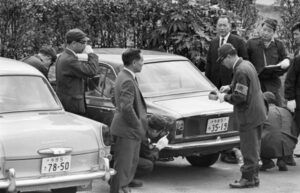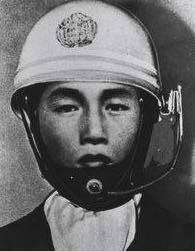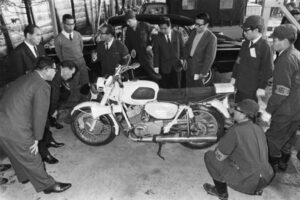 On December 10, 1968, the 300-million-yen robbery, also known as the 300-million-yen affair or incident, took place in Tokyo, Japan, when a man posing as a police officer on a motorcycle performed a “traffic stop” of some bank employees transferring money and stole about 294 million yen. This as half-century old unsolved heist remains the single largest heist in Japanese history. On that fateful day, four Kokubunji branch employees of the Nihon Shintaku Ginko (Nippon Trust Bank) were transporting 294,307,500 yen (about US$817,520 at 1968 exchange rates) in the trunk of a Nissan Cedric company car. It seems like a rather odd and very unsecure way to transfer such a large sum of money, but apparently, they saw no danger…a mistake they would most certainly regret. The money, contained in metal boxes was to be for bonuses for the employees of Toshiba’s Fuchu factory.
On December 10, 1968, the 300-million-yen robbery, also known as the 300-million-yen affair or incident, took place in Tokyo, Japan, when a man posing as a police officer on a motorcycle performed a “traffic stop” of some bank employees transferring money and stole about 294 million yen. This as half-century old unsolved heist remains the single largest heist in Japanese history. On that fateful day, four Kokubunji branch employees of the Nihon Shintaku Ginko (Nippon Trust Bank) were transporting 294,307,500 yen (about US$817,520 at 1968 exchange rates) in the trunk of a Nissan Cedric company car. It seems like a rather odd and very unsecure way to transfer such a large sum of money, but apparently, they saw no danger…a mistake they would most certainly regret. The money, contained in metal boxes was to be for bonuses for the employees of Toshiba’s Fuchu factory.
As the car proceeded along its route to the home of the bank manager for delivery to the factory, a young man in the uniform of a motorcycle police officer blocked the path of the car. Like most of us would do, when faced with an authority figure telling us to stop, the men in the car obeyed the “officer” and a mere 200 meters from its destination, on a street next to Tokyo Fuchu Prison they stopped. The impersonator informed the bank employees that their bank branch manager’s house had been destroyed by an explosion, and a warning had been received that a bomb had also been planted in the car. The four employees quickly exited the vehicle, while the police officer crawled under the car. Moments later, the “officer” he rolled out, shouting that the car was about to explode and telling the employees to run. Smoke and flames appeared underneath the car. The employees quickly retreated, and “police officer” got into it and drove away. I’m sure it took several moments for the employees to figure out that there was no bomb, and the “officer” wasn’t a selfless hero trying to get the car away from any innocent bystanders…especially when there was no explosion, and the “officer” didn’t come back. They were now faced with a new and unpleasant dilemma…telling their boss they had been duped.
The “police officer” had worked out his story well, telling the bank employees he knew about the bomb because  threatening letters had been sent to the bank manager beforehand. He was also prepared with a warning flare to create the smoke and flames he had ignited while under the car. At some point, the thief abandoned the bank’s car and transferred the metal boxes to another car, which he had stolen beforehand. Then, he also abandoned that car and transferred the boxes into to another previously stolen vehicle. He had laid out his plan very well, but there were, nevertheless, 120 pieces of evidence left at the scene of the crime, including the “police” motorcycle, which had been painted white. Unfortunately, the evidence was mostly common everyday items. It is believed that he scattered them around on purpose to confuse the police investigation…a planned which seems to have worked quite well too.
threatening letters had been sent to the bank manager beforehand. He was also prepared with a warning flare to create the smoke and flames he had ignited while under the car. At some point, the thief abandoned the bank’s car and transferred the metal boxes to another car, which he had stolen beforehand. Then, he also abandoned that car and transferred the boxes into to another previously stolen vehicle. He had laid out his plan very well, but there were, nevertheless, 120 pieces of evidence left at the scene of the crime, including the “police” motorcycle, which had been painted white. Unfortunately, the evidence was mostly common everyday items. It is believed that he scattered them around on purpose to confuse the police investigation…a planned which seems to have worked quite well too.
One suspect was the 19-year-old son of a police officer. That young man died of potassium cyanide poisoning on December 15, 1968. He had no alibi, which may not have meant anything, since the money was not found at the time of his death. His death was deemed a suicide, and he was considered not guilty, according to official record. There was simply no evidence to tie him to the crime. Another, arrest made on December 12, 1969, of a 26-year-old man, who was suspected by the Mainichi Shimbun, proved to be a dead end too, when his alibi checked out. The arrest was initially made on an unrelated charge, but on the day of the robbery, he was taking a proctored examination. The only resulting charge from that arrest was that of “abuse of power” as the arrest was made based on false pretenses.
The police launched a massive investigation, posting 780,000 composite pictures throughout Japan. Amazingly, the list of suspects (or as it really must have been, persons of interest) included 110,000 names. These had to have been people the police thought might possibly be able to carry off such a heist, because it would really be impossible to have that many real suspects. Approximately 170,000 policemen participated in the investigation, which was the largest investigation in Japanese history…or so the story goes. They gathered and examined fingerprints from the scene and comparison of them to those on file. In the end, six million fingerprints on file were compared individually, however not a single match was found.
On November 15, 1975, just before the statute of limitations for that crime was over, a friend of the 19-year-old suspect was arrested on an unrelated charge. He had a large amount of money and was suspected of the  robbery. He was 18 years old when the robbery occurred. The police asked him for an explanation for the large amount of money, but he refused to speak, and they were not able to prove that his money had come from the robbery. In December 1975, after a seven-year investigation, police announced that the statute of limitations on the crime had passed, and that the investigation was at an end. In a further slap to justice, as of 1988, the thief has also been relieved of any civil liabilities, which means that he can tell his story without fear of legal repercussions. Still, no one has ever stepped forward to “tell said story” either, which tends to further exasperate the authorities, because it is the unsolved crimes that torment a police officer the most.
robbery. He was 18 years old when the robbery occurred. The police asked him for an explanation for the large amount of money, but he refused to speak, and they were not able to prove that his money had come from the robbery. In December 1975, after a seven-year investigation, police announced that the statute of limitations on the crime had passed, and that the investigation was at an end. In a further slap to justice, as of 1988, the thief has also been relieved of any civil liabilities, which means that he can tell his story without fear of legal repercussions. Still, no one has ever stepped forward to “tell said story” either, which tends to further exasperate the authorities, because it is the unsolved crimes that torment a police officer the most.


Leave a Reply